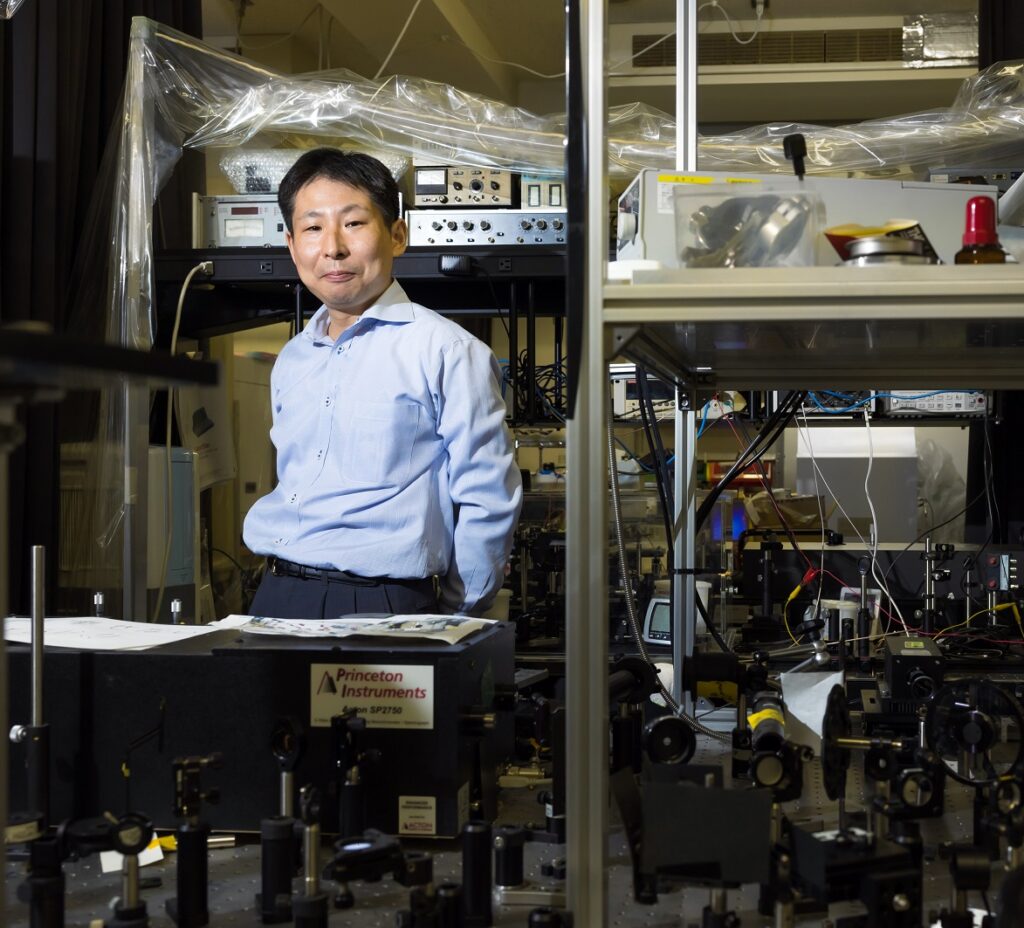
Professor Toshihiro Nakaoka of the Faculty of Science and Technology specializes in semiconductor microfabrication: technology for making nano-sized objects. One of his research themes using nanotechnology is joint research with Japan Aerospace Exploration Agency (JAXA) on an optical filter for observing invisible stars. What is nanotechnology research that will be crucial to unraveling the mysteries of the universe?
The formation of stars and planets in the universe is a subject that has yet to be fully explained. One key to understanding this mystery is infrared astronomy. This is a method of observing the universe using infrared rays, which have longer wavelengths than visible light. Currently, as joint research with JAXA’s Laboratory of Infrared Astrophysics, I am involved in the development of an optical element needed for astronomical observations using infrared.
In general, optical elements are lenses, filters, mirrors, and such found in optical devices such as cameras and projectors. The optical element which we are developing is an optical filter for obtaining information regarding stars found in the universe.
To explore the formation of stars, it is necessary to observe the galaxies and other areas where star formation is actively occurring. However, ultraviolet rays from young and hot stars are absorbed by cosmic dust and cannot be seen well. At the same time, dust warmed by these ultraviolet rays emit infrared rays, making infrared observation possible.
It is hoped that infrared astronomy will allow the observation of light spectra that were previously invisible. Is it possible to effectively focus infrared light? Can we properly extract only the desired lights?
We are taking on the challenge of developing an optical filter that makes this possible. My specialization is nanotechnology, but if things go well, I may be able to contribute toward unraveling the birth of stars and other mysteries of the universe.
Achieving high performance using transistors produced by nanotechnology

Nanotechnology is being applied to the development of optical elements. The core elements of computers and smartphones are called transistors, and today, these have been miniaturized to nano sizes.
My specialization is to use semiconductor microfabrication—which enables such miniaturization—to observe interesting physical phenomena and apply it to new elements, and this technology is also useful in the development of optical elements.
Serendipity—the discovery of the unexpected—makes research interesting
The basic approach of our research is to make things. While we carry out theoretical calculations to predict characteristics and compare actual experiments with computer simulations, we still emphasize the actual making of things.
For optical element research, we go to JAXA and work in a clean room that allows semiconductor microfabrication. There are also tasks to be performed at the university’s laboratory, and students shuttle between JAXA and the university to produce elements.
In research, while it is important to form hypotheses and carry out experiments for verification, I think the most interesting part is serendipity, which is the discovery of the unexpected. If we obtain characteristics that are opposite to those predicted, we pursue the reasons behind them.
There are lessons to be learned because things were not as expected. This high degree of freedom is the charm of university research. The optical element being developed now is also research that originates from serendipity.
It is also serendipity that led me to astronomy—a field that captivated me when I was a child—through continuing with research on optical physics and semiconductor microfabrication. I believe there is nothing better than undertaking interesting research while linking serendipity to create something that is useful to society in the future.
The book I recommend
“Hoshizora no Karyudo”(The Hunter of the Starry Sky)
by Tsutomu Seki, Chikumashobo

I came across this book in my fifth year at elementary school. It is a story about an amateur astronomer who searched for comets using a homemade telescope. This sparked my strong interest in astronomy, leading me to undertake research regarding light and eventually, joint research with JAXA. This book is what started it all.
-
Toshihiro Nakaoka
- Professor
Department of Engineering and Applied Sciences
Faculty of Science and Technology
- Professor
-
Graduated from the Department of Physics, School of Science, Osaka University and received his Ph.D. in Science after completing the doctoral program at the university’s Graduate School of Science. Took on several positions—such as a researcher at the University of Tokyo’s Institute of Industrial Science, PRESTO researcher at Japan Science and Technology Agency (JST), and associate professor at the Faculty of Science and Technology, Sophia University—before assuming his current position in 2017.
- Department of Engineering and Applied Sciences
Interviewed: June 2022